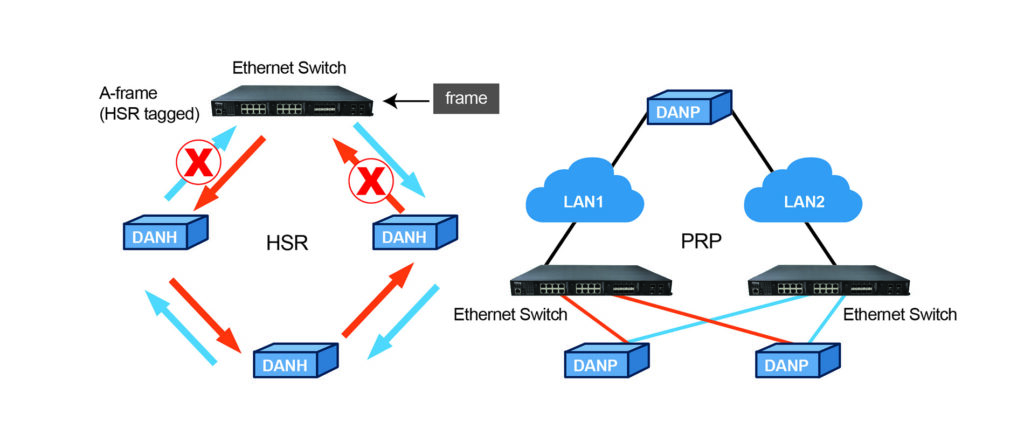As network applications become increasingly complex, requirements for network reliability and data transmission in domains such as power plants, trains, and industrial control have continued to rise. As a result, HSR (High Availability Seamless Redundancy) and PRP (Parallel Redundancy Protocol) have gained widespread popularity in recent years as network redundancy mechanisms.
Both of these two network redundancy protocols, specified in the IEC 62439-3 standard, can equip network communication systems with higher availability. Even in the event of link failures, no packets will be lost. However, both communication architectures have their pros and cons. To overcome the disadvantages of using them individually, businesses can adopt a network topology combining PRP and HSR, utilizing the strengths of each protocol to achieve optimized communications networks.
HSR utilizes a ring structure where all IEDs in the ring have two network interfaces (DANH, Double Attached Node for HSR). These two communication interfaces each transmit identical data frames in opposite directions around the ring. When the originating IED receives the frame it initially sent, it will discard that frame to avoid infinite looping. This data transmission approach can greatly reduce hardware investments, shorten average transmission times, and achieve seamless redundancy. However, the drawback is that communication transmission loads are greater, thus consuming more bandwidth resources.

PRP utilizes a parallel communication architecture where each IED is connected to two independent LANs, and the same data packet is transmitted on both of these independent paths. If one of the independent networks fails, the other remains unaffected, and there will not be any downtime for failure recovery. As a result, the strict real-time communication requirements of substation automation systems are upheld. While PRP requires double the equipment and incurs higher installation costs, the exceptional reliability of the redundant network design makes it suitable for applications such as ultra high-voltage substations or critical substations.
ORing Industrial Networking has launched a new-generation HSR/PRP module that can be applied to existing rackmount modular Ethernet switches: the RGS-P9000/PR9000 Series, achieving zero packet loss and zero-time recovery. Fully compliant with the requirements of IEC 61850-3 and IEEE 1613, the switch is designed for power substation applications.

This series supports IEC 61850 QoS, with the ability to prioritize GOOSE and SMV packets, and has a built-in MMS server that enables switch and IED monitoring via SCADA systems.
Product Information
RGS-P9000-LV: IEC 61850-3 Modular Cyber-hardened Managed L2 Ethernet Switch, 4 Slots, Dual 24/48VDC
RGS-P9000-HV: IEC 61850-3 Modular Cyber-hardened Managed L2 Ethernet Switch, 4 Slots, Dual AC/DC
RGS-PR9000-LV: IEC 61850-3 Modular Cyber-hardened Managed L3 Ethernet Switch, 4 Slots, Dual 24/48VDC
RGS-PR9000-HV: IEC 61850-3 Modular Cyber-hardened Managed L3 Ethernet Switch, 4 Slots, Dual AC/DC



